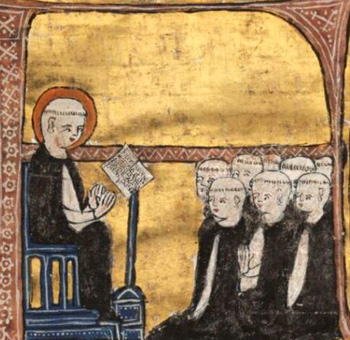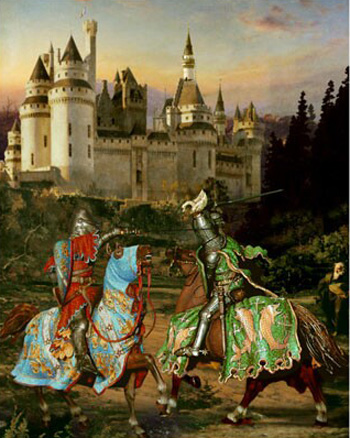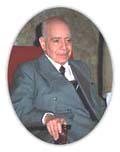Organic Society
 |
 |
 |
 |
 |
 |
 |
Personification of Principles - II
The Noble, a Model to be Imitated
In order to understand how the phenomenon of imitation works in society and how it should be institutionalized, the example of the Middle Ages can be useful.
What, properly speaking, is imitation?
Let us establish a presupposition to answer this question.
We must recognize that the majority of men do not have their minds expressly turned toward abstraction. They see things insofar as they are in concrete situations.

 For example, a person only knows maternal love or filial love when he sees a good mother or a good son. In principle, a person can have an abstract notion of maternal love without knowing a concrete example. But most of the people do not go to a compendium to read about the love a mother must have for her child. They analyze a good mother with her son; they have an intuition that her behavior is correct, and, from that experience, they arrive at some conclusions and rules on maternal love.
For example, a person only knows maternal love or filial love when he sees a good mother or a good son. In principle, a person can have an abstract notion of maternal love without knowing a concrete example. But most of the people do not go to a compendium to read about the love a mother must have for her child. They analyze a good mother with her son; they have an intuition that her behavior is correct, and, from that experience, they arrive at some conclusions and rules on maternal love.
By its nature, the human mind is turned to toward concrete situations. After seeing a certain number of properly ordered concrete examples, the mind comes to understand theoretically how the thing is. The concepts are not born from abstractions in order to apply to life, but rather are born from life and then reach the abstractions.
In high school, I had a colleague who had a manual of conversation. When he would go to a party, he would apply those rules to the conversations he had. I believe he had a deformed way of doing things. In fact, a person learns how to converse by conversing. Long after having engaged in many conversations, he perceives that there are certain rules he is intuitively following in those exchanges. The human mind first grasps concrete situations, and then it moves upward to the heights of abstraction.
In a similar way, man does not start practicing virtue by reading what virtue is in a catechism. He sees virtuous persons and those examples show him practically what virtue is. Afterward, the catechism completes the perfect process of learning. With the lessons of the catechism added to concrete examples, he has a complete notion of virtue. But it is by means of example that he has a living and concrete notion of how things are. It is through example that he forms his spirit.
Example, therefore, plays a primordial role in social life. Its role is primary regarding not only moral virtues, but any quality or capacity.
Let us take, for instance, this socio-cultural quality we call good taste. How do we acquire good taste? Good taste is an innate quality, but many people develop good taste by admiring those persons who have it, even when it is different from their personal preferences. By seeing what those persons do, listening to what they say and trying to imitate their actions and speech, one ends by understanding what good taste is and acquiring a little of it.
In brief, it is necessary to observe many concrete situations in order to learn how things should be.
The noble as a social model
This presupposition leads us to a higher idea. On other occasions, we have discussed many aspects of the nobility, but we still have not analyzed the noble as a model. This is an important function of any member of an authentic elite.
In the psychological order of things, the noble is made to be imitated. The noble per se is constituted to be an example for everything, to be imitated in everything.
He should set the pattern for all members of society in the way of living, thinking, acting and fighting. Everyone should model his life by following those patterns. This is one of the most important functions of the nobility.
How does the nobility fulfill this function?
Imagine an electrical current that passes through a certain metal. The electricity is there even though no one sees it. We only realize it is there when we touch the metal and get a shock. That current flows into the tungsten filament of an electric lamp, which offers a certain resistance that makes it incandescent. This is how that energy becomes light. This is why tungsten filament lamps produce illumination.
 I would say that the role of the noble is to take the electrical energy of knowledge and culture and transform it into light for the whole society. Indeed, the intellectual or university professor studies, accumulates a multitude of ideas, orders them into groups of principles and teaches them in the upper level classes of a country. The university professor and the intellectual are not necessarily from a high class in society since intelligence can appear in every class. No matter what his class, however, his role is to read and study. Afterward, he forms other intellectuals of a lower level who are the preceptors.
I would say that the role of the noble is to take the electrical energy of knowledge and culture and transform it into light for the whole society. Indeed, the intellectual or university professor studies, accumulates a multitude of ideas, orders them into groups of principles and teaches them in the upper level classes of a country. The university professor and the intellectual are not necessarily from a high class in society since intelligence can appear in every class. No matter what his class, however, his role is to read and study. Afterward, he forms other intellectuals of a lower level who are the preceptors.
A preceptor is a very intelligent man, but has a different kind of intelligence. He receives the higher learning from the university professor and then goes on to form children of noble families. He transforms that high learning he received into more accessible pedagogical merchandise. He gives children an education impregnated with that high learning.
The preceptor, strongly charged by the high learning energy, goes to form noble children. These children thus will have a strong intellectual discernment already in a type of tungsten filament stage. That learning enters the minds of those children not to discover new intellectual formulae, but to organize life in accordance with the principles they received in their cultural formation.
 How did the Scholasticism of St. Thomas become a cultural value incorporated into medieval society? It was through his students. Although many students were not from high social levels, some of his better pupils were chosen to educate the children of noble families. They formed those children in the logic, convictions and spirit of St. Thomas.
How did the Scholasticism of St. Thomas become a cultural value incorporated into medieval society? It was through his students. Although many students were not from high social levels, some of his better pupils were chosen to educate the children of noble families. They formed those children in the logic, convictions and spirit of St. Thomas.
Those children were meant to live scholastically, to build castles scholastically, entertain themselves scholastically; they would transform into action and life that which, in the mind of St. Thomas, was pure thought.
The function of the noble is, therefore, to transform thought into life, doctrine into reality. They should generate political and social organizations, artistic groups and currents; further they should produce highly cultured men. The nobles enter into society and create social and cultural organizations that shine with the intellectual electricity they received. Between theory and practice, here is the place for the nobility to exercise its role.
Application of the principles
Another example: The theologian teaches that Catholic doctrine has certain precepts regarding the way to treat the enemy. The enemy must be combated, but we have a certain obligation to treat him with integrity. Infamous weapons should not be used against him in combat.. Hatred for the enemy is legitimate, but it must be proportionate to the gravity of the offense received. Thus, we cannot inflict an atrocious damage on an enemy for an offense that was not atrocious. We also owe our enemy some degree of charity, which should be expressed in certain circumstances.
 What did the noble do with these moral principles? Inspired by them, the noble developed the rules and customs of Chivalry. The spirit of chivalry, as it became known, was an application of Catholic doctrine to the concrete situation of duels and war against enemies.
What did the noble do with these moral principles? Inspired by them, the noble developed the rules and customs of Chivalry. The spirit of chivalry, as it became known, was an application of Catholic doctrine to the concrete situation of duels and war against enemies.
The rule of duels that call for a man to be measured by his courage and not by infamous snares is a manifestation of respect for the enemy.
According to the rules of chivalry, the knight was encouraged to have a holy ire for the enemy, principally the religious enemy. That ire was directed to exterminate the enemy. But, when, for some reason, the combat stopped, when the enemy was no longer fighting but wounded or taken a prisoner, then, that hatred would change into love, into respect for the prisoner, into protection of the weak, etc.
This style of waging war became the reflection of Catholic doctrine on warfare and spread all over the West. This code, in its turn, constituted a set of values for an entire civilization.
Nobility transforms principles into lifestyles. These customs and styles end by being the actual realization of the social life of an area or country. The noble is, therefore, a model to be imitated.
Continued
What, properly speaking, is imitation?
Let us establish a presupposition to answer this question.
We must recognize that the majority of men do not have their minds expressly turned toward abstraction. They see things insofar as they are in concrete situations.

We understand maternal love by observing concrete situations rather than reading its definition in a book

By its nature, the human mind is turned to toward concrete situations. After seeing a certain number of properly ordered concrete examples, the mind comes to understand theoretically how the thing is. The concepts are not born from abstractions in order to apply to life, but rather are born from life and then reach the abstractions.
In high school, I had a colleague who had a manual of conversation. When he would go to a party, he would apply those rules to the conversations he had. I believe he had a deformed way of doing things. In fact, a person learns how to converse by conversing. Long after having engaged in many conversations, he perceives that there are certain rules he is intuitively following in those exchanges. The human mind first grasps concrete situations, and then it moves upward to the heights of abstraction.
In a similar way, man does not start practicing virtue by reading what virtue is in a catechism. He sees virtuous persons and those examples show him practically what virtue is. Afterward, the catechism completes the perfect process of learning. With the lessons of the catechism added to concrete examples, he has a complete notion of virtue. But it is by means of example that he has a living and concrete notion of how things are. It is through example that he forms his spirit.
Example, therefore, plays a primordial role in social life. Its role is primary regarding not only moral virtues, but any quality or capacity.
Let us take, for instance, this socio-cultural quality we call good taste. How do we acquire good taste? Good taste is an innate quality, but many people develop good taste by admiring those persons who have it, even when it is different from their personal preferences. By seeing what those persons do, listening to what they say and trying to imitate their actions and speech, one ends by understanding what good taste is and acquiring a little of it.
In brief, it is necessary to observe many concrete situations in order to learn how things should be.
The noble as a social model
This presupposition leads us to a higher idea. On other occasions, we have discussed many aspects of the nobility, but we still have not analyzed the noble as a model. This is an important function of any member of an authentic elite.
In the psychological order of things, the noble is made to be imitated. The noble per se is constituted to be an example for everything, to be imitated in everything.
He should set the pattern for all members of society in the way of living, thinking, acting and fighting. Everyone should model his life by following those patterns. This is one of the most important functions of the nobility.
How does the nobility fulfill this function?
Imagine an electrical current that passes through a certain metal. The electricity is there even though no one sees it. We only realize it is there when we touch the metal and get a shock. That current flows into the tungsten filament of an electric lamp, which offers a certain resistance that makes it incandescent. This is how that energy becomes light. This is why tungsten filament lamps produce illumination.

The role of nobility is to illuminate society with new institutions and styles
A preceptor is a very intelligent man, but has a different kind of intelligence. He receives the higher learning from the university professor and then goes on to form children of noble families. He transforms that high learning he received into more accessible pedagogical merchandise. He gives children an education impregnated with that high learning.
The preceptor, strongly charged by the high learning energy, goes to form noble children. These children thus will have a strong intellectual discernment already in a type of tungsten filament stage. That learning enters the minds of those children not to discover new intellectual formulae, but to organize life in accordance with the principles they received in their cultural formation.

St Thomas was able to influence the medieval institutions through his disciples who became preceptors of nobles
Those children were meant to live scholastically, to build castles scholastically, entertain themselves scholastically; they would transform into action and life that which, in the mind of St. Thomas, was pure thought.
The function of the noble is, therefore, to transform thought into life, doctrine into reality. They should generate political and social organizations, artistic groups and currents; further they should produce highly cultured men. The nobles enter into society and create social and cultural organizations that shine with the intellectual electricity they received. Between theory and practice, here is the place for the nobility to exercise its role.
Application of the principles
Another example: The theologian teaches that Catholic doctrine has certain precepts regarding the way to treat the enemy. The enemy must be combated, but we have a certain obligation to treat him with integrity. Infamous weapons should not be used against him in combat.. Hatred for the enemy is legitimate, but it must be proportionate to the gravity of the offense received. Thus, we cannot inflict an atrocious damage on an enemy for an offense that was not atrocious. We also owe our enemy some degree of charity, which should be expressed in certain circumstances.

A new style of fight based on loyalty and courage was born from the application of the principles of the Gospel
The rule of duels that call for a man to be measured by his courage and not by infamous snares is a manifestation of respect for the enemy.
According to the rules of chivalry, the knight was encouraged to have a holy ire for the enemy, principally the religious enemy. That ire was directed to exterminate the enemy. But, when, for some reason, the combat stopped, when the enemy was no longer fighting but wounded or taken a prisoner, then, that hatred would change into love, into respect for the prisoner, into protection of the weak, etc.
This style of waging war became the reflection of Catholic doctrine on warfare and spread all over the West. This code, in its turn, constituted a set of values for an entire civilization.
Nobility transforms principles into lifestyles. These customs and styles end by being the actual realization of the social life of an area or country. The noble is, therefore, a model to be imitated.
Continued

Posted April 7, 2014
Organic Society was a theme dear to the late Prof. Plinio Corrêa de Oliveira. He addressed this topic on countless occasions during his life - at times in lectures for the formation of his disciples, at times in meetings with friends who gathered to study the social aspects and history of Christendom, at times just in passing.
Prof. Plinio
Atila S. Guimarães selected excerpts of these lectures and conversations from the transcripts of tapes and his own personal notes. He translated and adapted them into articles for the TIA website. In these texts fidelity to the original ideas and words is kept as much as possible.
______________________
______________________












